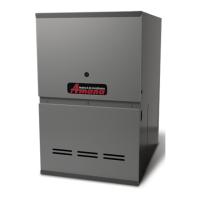28
3. Subtract the return air temperature from the supply air
temperature to determine the air temperature rise. Allow
adequate time for thermometer readings to stabilize.
4. Adjust temperature rise by adjusting the circulator blower
speed. Increase blower speed to reduce temperature rise.
Decrease blower speed to increase temperature rise. Refer
to Startup Procedure and Adjustment -Circulator Blower
Speeds for speed changing details.
SUPPLY
AIR
RETURN
AIR
Temperature Rise Measurement
Figure 34
diAgnoStiCS
Accessing the furnace’s diagnostic menu provides access to
the last six faults detected by the furnace. Faults are stored
most recent to least recent, Any consecutively repeated fault is
stored a maximum of three times. Example: A clogged return
air lter causes the furnace limit to trip repeatedly. The control
will only store this fault the rst three consecutive times the
fault occurs.
NOTE: It is highly recommended that the fault history be
cleared when performing maintenance or servicing the
furnace.
normal SequenCe of oPeration
power up
The normal power up sequence is as follows:
• 115 VAC power applied to furnace.
• Integrated control module performs internal checks.
• Integrated control module monitors safety circuits
continuously.
• The furnace enters a three minute power up delay to
make sure the system is setup properly. During this
time thermostat calls will not be recognized.
• Furnace awaits call from thermostat. 7-segment
LED’s display
Id L
while awaiting call from thermostat.
heAting mode
The normal operational sequence in heating mode is as
follows:
• W thermostat contact closes, initiating a call for heat.
• Integrated control module performs safety circuit
checks.
• Induced draft blower is energized on high speed for
a 15-second prepurge.
• Induced draft blower steps to low speed following
prepurge. Low stage pressure switch contacts are
closed.
• Igniter warm up begins upon Inducer draft blower
step to low speed and presence of closed low stage
pressure switch contacts.
• Gas valve opens at end of igniter warm up period,
delivering gas to burners and establishing ame.
• Integrated control module monitors ame presence.
Gas valve will remain open only if ame is detected.
• Based on the furnace internal control algorithms the
gas valve and induced draft blower may continue
operating on low stage or both will change to high
stage. After a power cycle, the rst gas heat call will
result in high stage operation.
• Circulator blower is energized on heat speed following
the selected blower on delay and will begin to ramp
up. Electronic air cleaner terminal is energized with
circulator blower.
• Furnace is now operating on the specied stage
determined by the internal control algorithm.
• Furnace runs, integrated control module monitors
safety circuits continuously.
• If the internal algorithm changes the call from low
heat to high heat, the integrated control module
will immediately switch the induced draft blower,
gas valve, and circulator blower to their high stage
settings.
• If the internal algorithm changes the call from
high heat to low heat, the control will immediately
switch the induced draft blower and gas valve to
their low stage settings. The circulator blower remains
on high heating speed for 30 seconds
before switching to the low heat circulating speed.
• The W terminal thermostat contacts open, which ends
the call for heat.
• The gas valve closes, extinguishing the ame.
• Induced draft blower is de-energized following a 15
second post purge.
• Circulator blower continues running for the selected
heat off delay period. The blower speed during this
period depends on the last heat call provided by the
thermostat. If the last call for heat was a call for low
heat, the air circulator motor will run on low heat
speed for the duration of the heat off delay period. If
the last call for heat was a call for high heat, the air
circulating motor will run on low heat speed for the
duration of the heat off delay period. If the last call

